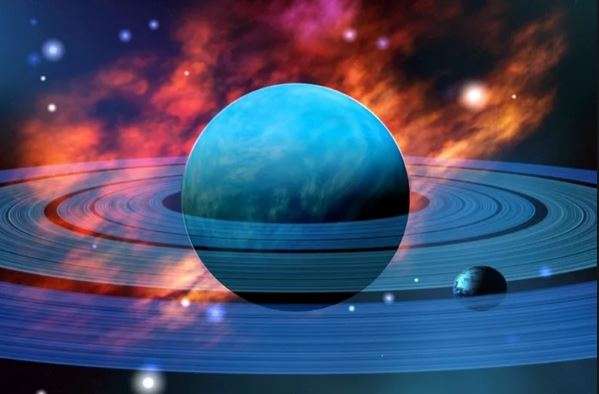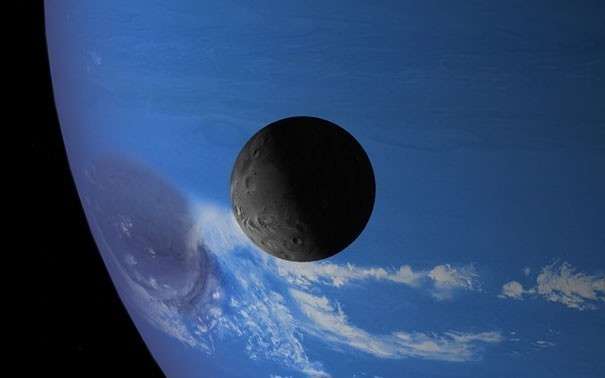With the beginning of active research into the distant parts of the solar system with the help of automatic interplanetary stations, information about the planet Neptune began to be replenished with new data. At the moment, Neptune is the last, eighth planet in the solar system, beyond which is only Pluto, recently transferred from the category of planets to planetoids due to its too small size. Neptune, on the contrary, is one of the four giant planets, which also include Uranus, Saturn and Jupiter, if you choose the direction from the periphery of the solar system to the central star. It was named after the ancient Roman god Neptune, the ruler of the oceans and seas, which is the best match with its bright blue appearance in the photographs.
Interesting facts about the planet Neptune begin with the very fact of its discovery. Neptune was the first cosmic object to be predicted before it was discovered.
Discovery of the planet Neptune
For almost the entire history of mankind, only five planets visible to the naked eye were known to him: all the stone planets (Mars, Venus and Mercury), as well as two gas giants (Jupiter and Saturn).
Back in the 19th century, scientists observing the movement of Uranus discovered its strange behavior, which could be explained by the presence of a massive object located further from the Sun. Initially, the Englishman John Adams made his own calculations and offered them in 1845 to the Greenwich Observatory, but they were simply ignored. A little later and completely independently, the Frenchman Urbain Le Verrier made his own calculations and presented them there as well. This time, Adams was also remembered in Greenwich, and from 1846 they began to observe the sky, however, they did not find anything. In the same year, Le Verrier submitted updated calculations to the Paris Observatory, but even there he was brushed aside. The disappointed Frenchman turned to the Berlin Observatory to Johann Galle.
The Paris Academy of Sciences caught on and began to shout to the whole scientific world that Neptune had discovered Le Verrier “on the tip of a pen", they were echoed on the other side of the English Channel, changing only the surname to Adams. As a result, in order not to offend either one or the other, a Solomonic decision was made – Galle was recognized as the discoverer, but with the obligatory indication of the theoretical predictions of Adams and Le Verrier. So no one was offended.
They named the newly discovered planet in honor of the ancient Roman sea ruler Neptune. This name was simply a tribute to the tradition of using the names of the gods of the Roman pantheon to designate the planets, but much later it turned out that the choice was extremely successful. When the American Voyager 2, heading for the outskirts of the solar system, flew past this planet in 1989, he took a photo of the planet Neptune from space, in which he appeared in an amazingly beautiful, deep blue color, which is perfectly combined with "profession of this deity. To do this, after exploring the first three giant planets, the device had to fly only 45,000 km from the last of them.
Video about the planet Neptune
Features of the planet Neptune
The bright blue color of Neptune’s clouds is due to the presence of as yet undetermined organic matter, as well as the fact that methane is present in the hydrogen-helium atmosphere of the planet, actively absorbing red light. The giant planet is 17 times heavier than the Earth, and 58 times larger in volume. It is assumed that the stone core of Neptune is approximately equal to the mass of our planet. In addition to gas, there is a lot of ice made from methane, water and ammonia.
Neptune is so far from the Sun that it looks slightly larger than the brightest star from this distance, and is obviously not capable of giving it much light energy. Despite this, this planet is the most violent in the solar system. The most powerful hurricanes in the solar system rage here, and wind speeds can reach 2100 km / h – such is the weather on the planet Neptune. On Earth, it is simply impossible to imagine such a speed.
With respect to the plane of rotation of Neptune, its magnetic poles have an inclination of about 47 degrees, and the strength of the field itself is 27 times greater than that of the earth. Such conditions cause the most powerful vibrations and perturbations on the planet with each of its revolutions.
Video about the planet Neptune
Atmosphere of the planet Neptune
At Neptune, the atmosphere is inseparable from the outer gaseous shell, its total thickness exceeds 5 thousand kilometers, and it consists of hydrogen (80%), helium (19%) and 1.5% methane. The planet is unlikely to have a clear, solid surface, there is no real boundary between the atmosphere and the ice layer, just under the terrible pressure of the upper layers, the density of matter gradually increases, and it passes into the solid phase. At first, gases under pressure crystallize, the number of crystals gradually increases until they form an ice mass in depth. Such a transition occurs at a depth of about three thousand kilometers.
The structure of the bowels of the planet Neptune
Scientists suggest that about a quarter of the mass of Neptune is rock, most (60-80%) is ice and the remaining 5-15% is the atmosphere. Therefore, Neptune is considered, first of all, an ice giant. Computer modeling gave the diameter of the stone core of the planet, one and a half to two times the size of the earth’s core. The main mass of the planet is concentrated in ices made of ammonia and water. These are very unusual "hot" ices: their temperature is in the range of 2500-5500 degrees, but despite this, due to the colossal pressure, millions of times higher than the earth’s, they continue to remain solid. Ice molecules are so tightly pressed against each other that they inevitably deform and ionize, losing free electrons.
Rings and moons of Neptune
At the moment, 14 satellites have been found near Neptune, whose names are given in honor of the younger gods and nymphs who obeyed the god Neptune. The largest satellite of the planet Neptune Triton is unique to many:
- was discovered almost simultaneously with the planet itself;
- concentrated in itself 99.5% of the entire mass of the material of the satellites of Neptune, so he is the only one who was able to form a round body (the rest of the irregularly shaped satellites are dust in comparison with him);
- it is the only large satellite in the entire solar system that has a retrograde orbit, that is, it spins in the opposite direction from the rotation of the planet. This suggests that Triton was once a dwarf planet and was captured by Neptune’s gravity.
Neptune has rings, but not like those of Saturn: they are not the same, they have arcs of bright thick clots of dust. These rings are believed to be young and temporary, and recent photos of the planet Neptune show their instability.
Great Dark Spot on Neptune
This spot somewhat resembled the Great Red Spot observed on Jupiter for 300 years. This grandiose hurricane, like the Jupiter spot, is an anticyclone. It was discovered by Voyager 2 in 1989, but it did not turn out to be a long-liver – at least in 1994, Hubble did not find anything. This spot was approximately the size of the Earth, and the winds around it were blowing at a speed of 2400 km / h. The shape and size of the Great Dark Spot constantly changed until it completely disappeared. After the disappearance of this spot, a new one appeared, called the "northern great dark spot."
Despite a relatively short history, the planet Neptune in astrology has already acquired a whole bunch of legends and predictions, but this is a separate issue.




